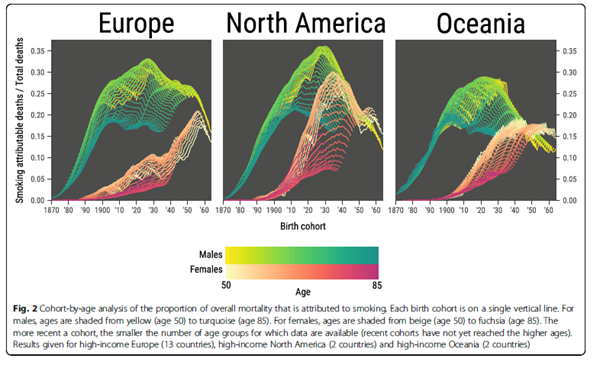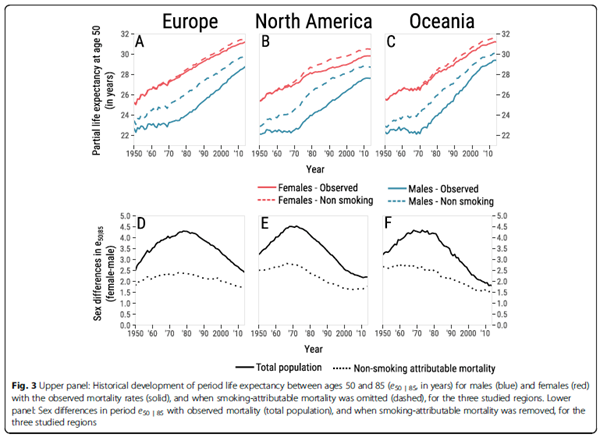
Progression of the smoking epidemic in high-income regions and its effects on male-female survival differences: a cohort by age analysis of 17 countries
We look at effects of smoking on mortality differences between men and women in high income countries over the period 1950 and 2015. The findings suggest that smoking is the major reason for sex differences in mortality in the last decades in high income countries and that about half of the sex differences in life expectancy can be attributed to smoking.
We found that in all three high-income regions, smoking explained up to 50% of sex differences in period life expectancy between ages 50 and 85 over the study period. These sex differences have declined since at least 1980, driven by smoking-attributable mortality, which tended to decline in males and increase in females overall. Thus, there was a convergence between sexes across recent cohorts. While smoking-attributable mortality was still increasing for older female cohorts, it was declining for females in the more recent cohorts in the US and Europe, as well as for males in all three regions.
Thus, the smoking epidemic thus contributed substantially to the male-female survival gap and to the recent narrowing of that gap in high-income North America, high-income Europe and high-income Oceania. The precipitous decline in smoking-attributable mortality in recent cohorts bodes somewhat hopeful. Yet, smoking-attributable mortality remains high, and therefore cause for concern.


Authors:
Maarten Wensink, 1, 2.
Jesús-Adrián Alvarez, 1.
Silvia Rizzi, 1, 2.
Fanny Janssen, 3, 4.
Rune Lindahl-Jacobsen, 1, 2.
Authors affiliation:
1. Interdisciplinary Centre on Population Dynamics, University of Southern Denmark, Odense, Denmark.
2. Department of Public Health, University of Southern Denmark, Odense, Denmark.
3. Population Research Centre, Faculty of Spatial Sciences, University of Groningen, Groningen, The Netherlands.
4. Netherlands Interdisciplinary Demographic Institute, The Hague, The Netherlands.
Corresponding author: Maarten Wensink, mwensink@health.sdu.dk, Interdisciplinary Centre on Population Dynamics, University of Southern Denmark, Odense, Denmark
Cite this article
Wensink, M., Alvarez, J., Rizzi, S. et al. Progression of the smoking epidemic in high-income regions and its effects on male-female survival differences: a cohort-by-age analysis of 17 countries. BMC Public Health 20, 39 (2020) doi:10.1186/s12889-020-8148-4
Online access: here